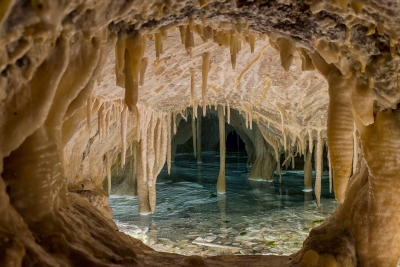
|
Caves are natural hollows formed underground, usually large enough for a human to enter. Even though the entrance may seem small and narrow, it may open up to be wider, or lead into deep underground passages. Most caves are formed over a long period of time by the gradual erosion of rock by water. |
Caves, also called cavern, natural opening in the earth large enough for human exploration. Such a cavity is formed in many types of rock and by many processes. The largest and most common caves are those formed by chemical reaction between circulating groundwater and bedrock composed of limestone or dolomite. These caves, called solution caves, typically constitute a component of what is known as karst terrain. Named after the Karst region of the western Balkan Peninsula extending from Slovenia to Montenegro, karst terrain in general is characterized by a rough and jumbled landscape of bare bedrock ledges, deranged surface drainage, and sinkholes, as well as caves. It should be noted, however, that there is considerable variation among karst areas. Some may have dramatic surface landforms but few caves. By contrast, others may have extensive cave development with little surface expression; for example, the Guadalupe Mountains of New Mexico, the site of Carlsbad Caverns and various other caves, have very few surface karst features.
Not all caves are part of karst landscapes. A substantial number of relatively small caves, called volcanic caves, are formed in lava and by the mechanical movement of bedrock. Other caves are formed in glaciers by the melting of ice. Still others are created by the erosive action of water and wind or from the debris of erosive processes; these are sea caves, eolian caves, rock shelters, and talus caves.
Credit: Britannica
Picture Credit : Google




